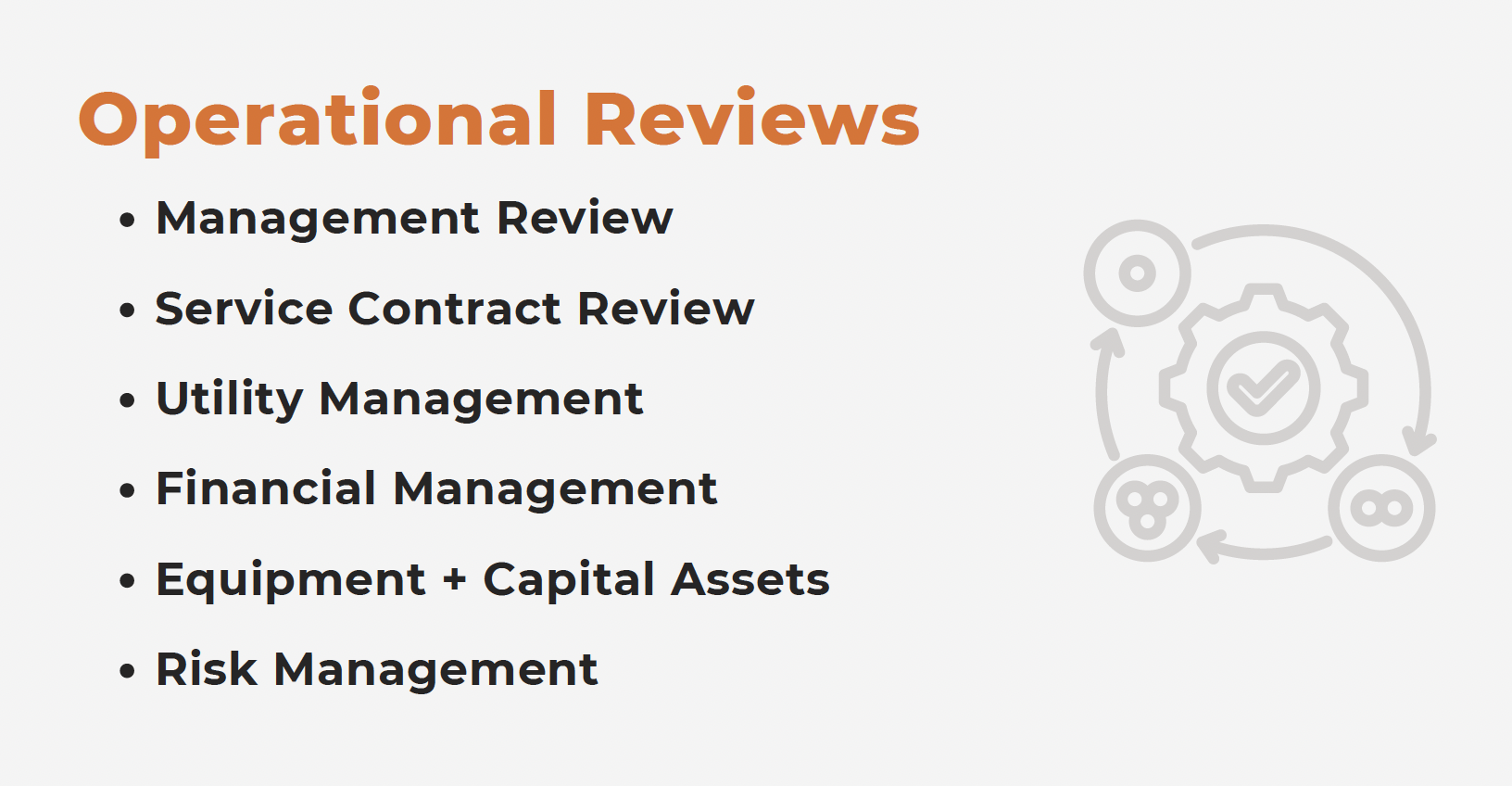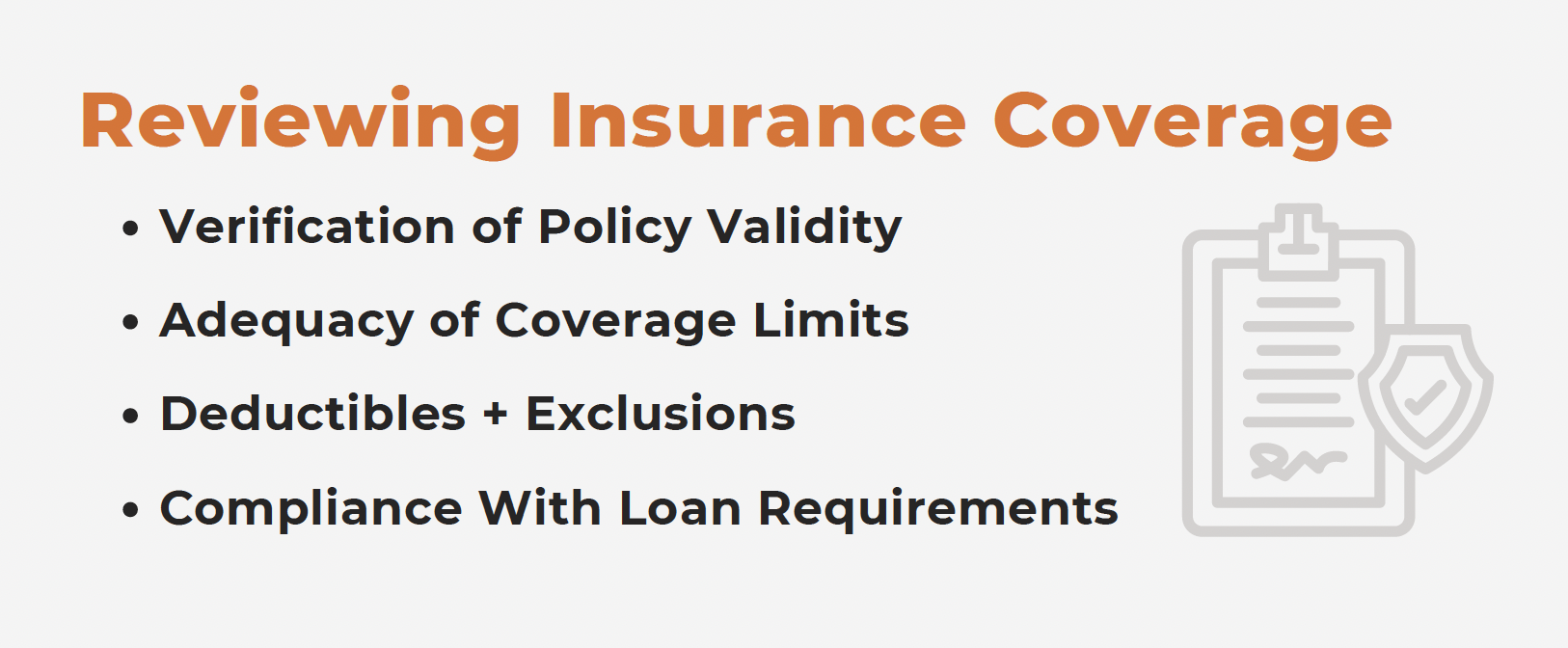Ensuring Investment Success: Comprehensive Due Diligence Strategies for Commercial Real Estate – Part 4
This is the fourth installment in our in-depth series on due diligence strategies for commercial real estate, an essential topic for anyone who buys or invests in commercial real estate of any type. This post is on operational reviews—thoroughly assessing every aspect of a commercial property’s operations—and insurance coverage examination, a specialty within due diligence but a critical component of a sound and thorough due diligence strategy.
Operational Reviews
An operational review during the due diligence phase of a commercial real estate transaction assesses the efficiency and effectiveness of the property’s operations. This comprehensive review helps to identify any potential issues that could affect the property’s profitability or operational stability. Below is a detailed look at the main components and processes involved in an operational review:
1. Management Review
Assessment of Current Management
Evaluate the capabilities and track record of the current property management team. This includes reviewing their responsiveness, tenant satisfaction levels, operational efficiencies, financial management, and adherence to budgets.
Property Management Contracts
Analyze existing property management agreements to understand the terms, responsibilities, compensation structure, and the ease or conditions for termination.
Management Practices
Review the standard operating procedures, maintenance schedules, and service standards to ensure they meet industry norms and are capable of preserving or enhancing the value of the property.
2. Service Contracts Review
Existing Service Agreements
Review all existing contracts related to the property, such as landscaping, janitorial services, security, and other third-party services. Assess these for cost-efficiency, service level agreements, and contractual obligations.
Costs and Conditions
Examine the costs involved with these services and compare them to typical market rates to ensure the property is not overpaying. Also, check for any long-term contracts that could limit flexibility in managing the property.
Vendor Performance and Reliability
Evaluate the reliability and reputation of contracted vendors through past performance reviews, tenant feedback, and by checking any breaches or disputes in service delivery.
3. Utility Management
Utility Consumption Analysis
Review utility usage and costs to determine if there are any inefficiencies or areas where savings could be made (e.g., through more efficient heating systems or LED lighting).
Sustainability Measures
Assess existing sustainability practices and infrastructure, such as energy-efficient fixtures, recycling programs, and water conservation measures.
4. Financial Management
Budgeting and Financial Reporting
Analyze past budgets and financial reports to assess the accuracy of financial forecasting and the presence of any irregular financial patterns.
Revenue and Expense Verification
Verify all sources of income and expenditures. This includes checking the alignment of reported financial data with actual bank statements and receipts.
5. Equipment and Capital Assets
Condition and Maintenance of Equipment
Evaluate the condition and maintenance records of major equipment like HVAC systems, elevators, roofing, and others. This helps to forecast potential capital expenditures and to assess if the equipment has been properly maintained.
Capital Expenditure Planning
Review historical capital expenditures and future CapEx plans to ensure that there is a strategy in place for building maintenance and improvements that aligns with the property’s long-term value preservation.
6. Risk Management
Insurance Coverage Analysis
Review all insurance policies to ensure adequate coverage against potential risks, including property damage, liability, and loss of income insurance.
Compliance with Laws and Regulations
Ensure that the property and its operations comply with all relevant laws and regulations, including safety codes, employment laws, and accessibility requirements.
A Final Insight on Operational Reviews of Commercial Properties
Conducting a thorough operational review allows investors to gauge the operational viability and cost-efficiency of a commercial real estate property. This process identifies areas where improvements can be made and risks might be mitigated to enhance overall property value and operational smoothness. It’s often beneficial to involve specialists in property management, financial analysis, and systems engineering to perform this review, ensuring that all aspects of property operations are optimally aligned with business objectives.
Insurance Coverage Examination
Insurance coverage examination involves reviewing all existing insurance policies associated with the property to ensure adequate protection against potential risks and liabilities. A thorough insurance review not only verifies compliance with legal requirements but also helps in assessing financial risks that might impact the investment’s value. Here’s a detailed overview of the steps and considerations involved:
1. Types of Insurance Policies
Property Insurance
Covers damage to buildings and personal property due to events like fire, storm, or vandalism. It’s important to confirm that the coverage limits are adequate to replace or repair the property in case of total loss.
Liability Insurance
Protects against claims of property damage or personal injury caused to others by the property owner’s negligence. This includes slip and fall accidents or other liabilities occurring on site.
Business Interruption Insurance
Compensates for lost income and other expenses incurred when the property is unusable due to covered perils like fire or natural disasters.
Casualty or General Liability Insurance
Provides broader coverage including legal defense costs for liabilities not specifically excluded in the policy.
Flood Insurance
Required for properties in flood-prone areas as defined by national flood insurance maps. It covers damage due to flooding, which is typically not covered under standard property insurance policies.
Environmental or Pollution Insurance
Covers costs related to pollution cleanup and claims for property damage or injuries caused by environmental contamination.
2. Reviewing Insurance Coverage
Verification of Policy Validity
Confirm that all insurance policies are current and premiums are paid up to date.
Adequacy of Coverage Limits
Review the coverage limits to ensure they are sufficient to cover the full replacement cost of the property and adequate for potential liabilities.
Deductibles and Exclusions
Analyze the policy deductibles and exclusions to understand what is not covered and any potential out-of-pocket expenses in the event of a claim.
Compliance with Loan Requirements
Ensure that insurance coverage meets or exceeds all requirements stipulated by potential lenders or existing loan agreements.
3. Assessing Risk Exposure
Risk Identification
Identify all potential risks associated with the property, including natural disasters, structural risks, and potential liabilities from tenant activities.
Risk Quantification
Estimate the potential financial impact of these risks to determine if the current insurance coverage is adequate.
4. Negotiating Insurance Terms
Policy Enhancements
Based on the risk assessment, negotiate with insurance providers to increase coverage limits, reduce deductibles, or include additional risks not currently covered.
Cost Optimization
Compare insurance costs with other providers to ensure competitive pricing and explore opportunities to reduce premiums without compromising coverage quality.
5. Continuous Monitoring and Updating
Regular Policy Reviews
Conduct regular reviews of all insurance policies to adjust coverage as the property and its uses evolve and as market conditions change.
Staying Informed About Changes in Legislation
Keep abreast of changes in local, state, and federal insurance legislation that might affect coverage requirements or liability risks.
A Final Word on Examining Insurance Coverage on Commercial Properties
The examination of insurance coverage during the due diligence process is essential for protecting a real estate investment against unforeseen losses and liabilities. It ensures that any potential risks are properly managed with adequate insurance, thereby safeguarding the asset’s value and the owner’s financial interests. Effective management of insurance aspects requires collaboration with experienced insurance brokers or consultants who specialize in commercial real estate to achieve optimal coverage terms and costs.
More On Due Diligence Strategies for Commercial Real Estate
If you’d like more information and expert tips and insights on due diligence for commercial real estate, we invite you to read the first three installments in our series, Ensuring Investment Success: Comprehensive Due Diligence Strategies for Commercial Real Estate.
- Part 1 covers property and building inspections and title and ownership verification
- Part 2 is on financial due diligence and market and area analysis
- Part 3 looks at tenant and lease analysis and environmental assessments
For more information on Realogic’s suite of due diligence services for commercial real estate owners and investors, visit the due diligence page on our website or contact us at info@realogicinc.com or 312-782-7325.
About The Author
Mike Phelps is Realogic’s General Counsel. Mike has over 20 years of commercial real estate experience, including with financial modeling and analysis, analysis of acquisitions and dispositions, due diligence, underwriting, development and review of financial proformas and Argus/Dyna training. In his current role, he supports all of Realogic’s business lines and provides counsel on corporate, employment and compliance issues. He is also responsible for negotiation of contracts, master service agreements, software licenses and subscriptions and other intellectual property matters. Mike welcomes your comments on his post. He can be reached at mphelps@realogicinc.com

